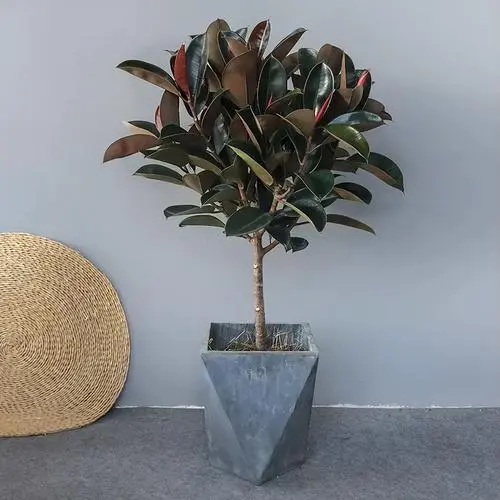The Comprehensive Guide to Caring for Rubber Trees at Home

Suitable Plants for Home Cultivation
Rubber trees are very suitable for home cultivation. They are vigorous and resilient, and do not require overly complex care. When choosing a rubber tree, pay attention to select a robust plant with full leaves and no pests or diseases. In addition, rubber trees come in a variety of types, including large-leaved rubber trees, small-leaved rubber trees, and variegated rubber trees. You can choose according to your preferences and the style of your home decor.
Growing Environment
Rubber trees prefer a warm and humid environment. The suitable temperature is 18-28°C, and not lower than 15°C in winter. They like light, but are not tolerant of direct sunlight. Therefore, when caring for them at home, you can place them in a bright place, but avoid direct sunlight. In addition, rubber trees require high air humidity. If the air is too dry, it will cause the edges of the leaves to turn yellow, so pay attention to maintaining air humidity. You can increase the air humidity by spraying water.
Watering
The watering requirement for rubber trees is "better dry than wet". Too much water can cause root rot. Generally speaking, water once a week in spring and summer, and once every two weeks in autumn and winter. When watering, water thoroughly so that the water flows out from the bottom of the pot. This can ensure that the roots of the rubber tree get enough water.
Fertilizing
Rubber trees do not require much fertilization. Generally speaking, fertilize once a month in spring and summer, and stop fertilizing in autumn and winter. When fertilizing, you can choose a compound fertilizer rich in nitrogen, phosphorus, and potassium, or you can choose organic fertilizers, such as chicken manure.
Pruning
Pruning of rubber trees is mainly to maintain a beautiful plant shape and control the growth rate. Generally speaking, spring is the best time for pruning. When pruning, be careful not to cut off too many leaves to avoid affecting the photosynthesis of the rubber tree.
Pest and Disease Control
Common pests and diseases of rubber trees include leaf spot disease, root rot, and aphids. The main methods of prevention and control are to maintain environmental hygiene, regularly check the plants, and deal with pests and diseases in time. For leaf spot disease and root rot, systemic fungicides can be used for prevention and control. For aphids, insecticides can be used for prevention and control, or the plants can be sprayed with soapy water to drive away the aphids.
Using an APP for Auxiliary Care
With our carefully crafted "Bloomia" APP, you can easily manage and record the care process of your rubber tree. Whether it's watering, fertilizing, or pruning, every care operation can be recorded in the APP, making your gardening journey orderly. What's more, the "Bloomia" APP also provides a care reminder function. You can set reminders according to the care needs of the rubber tree, so you no longer have to worry about forgetting to water or fertilize. In addition, the "Bloomia" APP allows you to record every growth moment of the rubber tree with photos. Whether it's the tender green of new leaves unfolding, or the fullness of vigorous growth, all can be captured in photos, allowing you to savor the green tranquility and joy anytime in your busy life.